- English
- Español
- Português
- русский
- Français
- 日本語
- Deutsch
- tiếng Việt
- Italiano
- Nederlands
- ภาษาไทย
- Polski
- 한국어
- Svenska
- magyar
- Malay
- বাংলা ভাষার
- Dansk
- Suomi
- हिन्दी
- Pilipino
- Türkçe
- Gaeilge
- العربية
- Indonesia
- Norsk
- تمل
- český
- ελληνικά
- український
- Javanese
- فارسی
- தமிழ்
- తెలుగు
- नेपाली
- Burmese
- български
- ລາວ
- Latine
- Қазақша
- Euskal
- Azərbaycan
- Slovenský jazyk
- Македонски
- Lietuvos
- Eesti Keel
- Română
- Slovenski
- मराठी
- Srpski језик
How does the cleaning cycle of a soft flow dyeing machine affect production efficiency?
2025-08-07
In modern textile printing and dyeing production, the stable and efficient operation of soft flow dyeing machines is crucial for ensuring both productivity and quality. Recent industry observations have shown that scientifically defining and strictly adhering to cleaning and maintenance cycles for this equipment is becoming an effective way for companies to tap into production potential and reduce overall costs. Neglecting routine cleaning and maintenance can easily lead to dye residue accumulation, nozzle blockage, or reduced heat exchange efficiency, resulting in frequent downtime and rework.
The cleanliness of the internal flow channels and heat exchangers of a soft flow dyeing machine directly determines its performance. A large knitting mill significantly improved its operational stability by switching from intermittent cleaning cycles to a precise, mandatory deep cleaning every 20 batches. The first-pass yield for fabrics increased by nearly 5%, unplanned downtime due to blockages decreased by over 30%, and average dyeing time per vat was reduced by approximately 8%. This demonstrates that timely removal of residue from pumps, valves, filters, and cloth rollers significantly optimizes heat exchange efficiency and dye liquor circulation.
Precisely managing the cleaning rhythm of a soft-flow dyeing machine is more than a simple cost expenditure; it is a key investment in production efficiency. The current industry consensus is shifting towards the principle that dynamically developing customized cleaning plans based on the fabric type, dye properties, and water quality are essential for ensuring optimal long-term operation of soft flow dyeing machines. This proactive maintenance approach not only increases equipment capacity and reduces water, electricity, and gas consumption, but also fundamentally enhances companies' delivery capabilities and market competitiveness, injecting new momentum into sustainable production.





